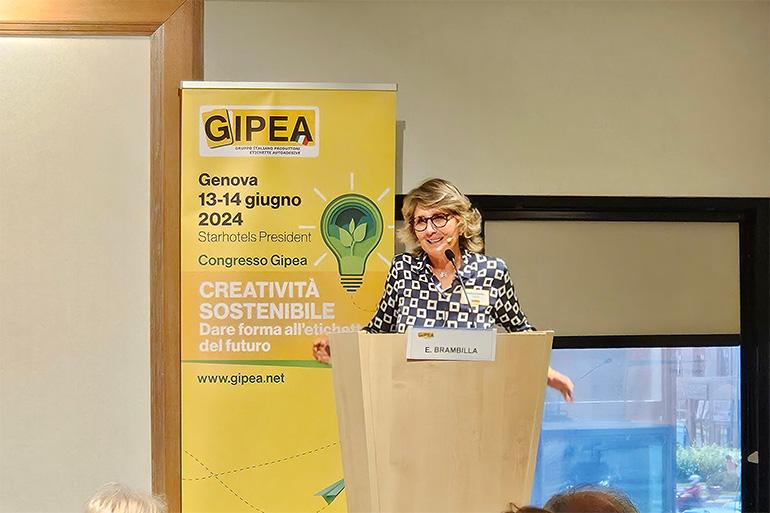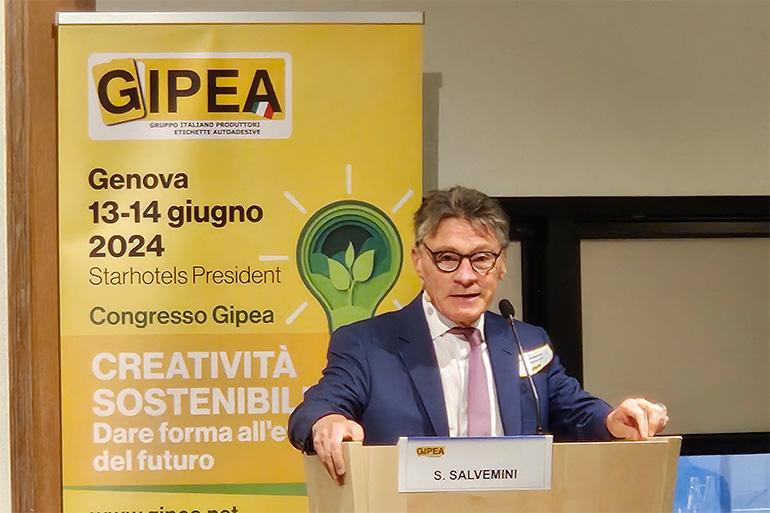Giving shape to the label of the future
Creative and sustainable, attentive to the economy and to gender parity: producers and processors of self-adhesive labels met together at the GIPEA 2024 Congress to discuss the complex issues affecting the packaging sector, highlighting the new values of labels.
M. Costanza Candi
Taking place in Genoa on 13 and 14 June, Gipea’s annual Congress brought together members for two days of analysis characterised by an unconventional approach to the labels market, a segment considered accessory to packaging but which is, in fact, a fundamental element. Contribution included a focus on technologies with leaders like BOBST and Avery Dennison, but also analyses on the most debated issues of the moment, like AI, the PPWR and the UNI/PdR 125:2022 certification of gender parity presented by Ayming Italia.

The label: cornerstone of the relationship between the customer and the product.
The congress was also an important institutional occasion, with greetings from the outgoing President, Elisabetta Brambilla, and from Stefano Salvemini, who is to take over as President, both interviewed by ItaliaImballaggio during the event. In Brambilla’s view, notwithstanding the release of the PPWR,
«the label is a fundamental component of packaging». A reduction in volumes, as a result of both a drop in families’ consumption and thanks to the provisions of the regulation, is certainly a complex challenge for the packaging sector, but the real issue, according to Brambilla, relates to the way in which the legislator views packaging in general. «Those who write the rules need to ask themselves how to move products while guaranteeing their hygiene, preservation and obtain a reduction in waste, seeing packaging as an indispensable tool and labels as a fundamental accessory. The sector is certainly interested in the question and seeks, when possible, to develop labels and inks which are increasingly less impactive, mono-material, and made of recycled and recyclable material. The sector’s aim is to create packaging which is intelligent in its design and sustainable and which responds to suppliers’ and consumers’ demands, but without losing focus on its real functions, which are the protection of its contents and the transmission of important information for the consumer».
The reflection then turned to the areas on which the President has worked to create a strong identity and shared tools, in order to prepare a shared basis for discussion, especially on a central theme such as sustainability.
«There’s great attention on the package, which is not perceived by the user as a product which offers services in itself, but is seen only as post-consumption waste. It’s necessary, therefore, to communicate and transmit the functional aspect of packaging, which should not be seen only as waste. This applies even more strongly to the label, which does not receive the right consideration despite being a fundamental vehicle of communication, information and a cornerstone of the relationship between the customer and the product. It is also for this reason that I have worked in these years in Gipea on clear communication. Our aim as an association is to enable the sector and its entrepreneurs to grow, constructing a shared image and values, working to create a creative, sustainable and resilient sector and to affirm together the value of our product: the label ».

Extending the association’s base towards the south, focusing on innovation and sustainability For the newly-appointed President of Gipea, Stefano Salvemini, the priorities are linked to the training of the sector and to the growth of members, especially in less represented areas:
«My first objective is to extend the geographical coverage of the association also into the south, where important business contexts are developing. We are aiming, therefore, to create a networking activity that benefits everyone, but which is also able to include companies that are not yet part of the Gipea universe. Looking then at the PPWR, the aspect of greatest impact is the transformation into composite packaging that labelling entails, if associated with different materials. The application of the label, in fact, transforms the nature of a package, generating a series of fundamental reflections on the importance of the mono-material. The label, in fact, plays a role that has to be governed. Composite packaging, although less recyclable, is often indispensable for ensuring a barrier effect and an adequate shelf-life, and for mitigating the risk of migration of the printed parts towards the product. The application of a label risks, however, transforming a mono-material into a composite one, with all the relevant environmental disadvantages. Our segment must work hard on new labelling materials, providing solutions to customers for maintaining the mono-material characteristics of the packaging, so as not to alter the original status of a package, especially when it is not created composite».
Technological innovation also finds a place in the neo-President’s reflections, who focuses on the relationship between labelling and traceability.
«Considering smart-packaging and technological evolutions in general - he continues - we intend to develop ad hoc training activities for members, gathering feedback from both customers and machine producers, in a constant dialogue with the market. We can then refer to the problems of tracking and km zero, on which digital technologies have a great impact, creating opportunities for new products that take anti-counterfeiting into consideration, not only in luxury packaging, but also for mass retail. We can mention invisible sequence numbering, which make it possible to identify the single product, establishing its origin and production path: all opportunities for strengthening our position as suppliers and for protecting the position of our customers ».
A variety of reflections for a global vision
Gipea’s orientation towards communication, networking and training also emerged in the in-depth contributions that ranged from an analysis of the economic scenario by Carlo Stagnaro, Director of Research and Studies at the Bruno Leoni Institute, to the PPWR analysed for legislative updates by Italo Vailati, Secretary of Gipea and Vice-director of Assografici and by Alberto Palaveri. The President of Giflex spoke in particular about new challenges, highlighting the role of the label segment in the path towards sustainability and emphasised the importance, for the association, of being proactive and communicative with the rest of the supply chain and with the institutions.


















